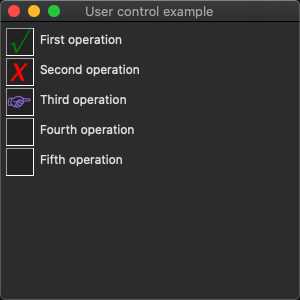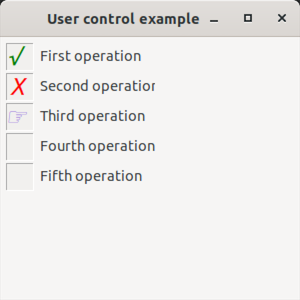The following code example demonstrate the use of user control.
#include <vector>
#include <xtd/xtd>
using namespace std;
namespace examples {
enum class operation_status {
none,
running,
succeed,
failed
};
public:
operation() {size_ = default_size();}
operation_status status() const {return status_;}
void status(operation_status status) {
if (status_ != status) {
status_ = status;
invalidate();
}
}
protected:
user_control::on_paint(e);
auto status_rectangle =
rectangle {1, 1, 28, 28};
e.graphics().fill_rectangle(
solid_brush(color::dark(back_color())), status_rectangle);
auto status_string = std::map<operation_status, ustring> {{operation_status::none, u8""}, {operation_status::running, u8"☞"}, {operation_status::succeed, u8"√"}, {operation_status::failed, u8"X"}}[status()];
auto status_brush =
solid_brush(std::map<operation_status, color> {{operation_status::none, fore_color()}, {operation_status::running, color::yellow}, {operation_status::succeed, color::green}, {operation_status::failed, color::red}}[status()]);
e.graphics().draw_string(status_string,
drawing::font(default_font(), 18, font_style::italic), status_brush, status_rectangle,
string_format().
alignment(string_alignment::center).line_alignment(string_alignment::center));
e.graphics().draw_line(
pen(color::dark(color::dark(back_color()))), status_rectangle.location(),
point(status_rectangle.width(), 1));
e.graphics().draw_line(
pen(color::dark(color::dark(back_color()))), status_rectangle.location(),
point(1, status_rectangle.height()));
e.graphics().draw_line(
pen(color::light(color::light(back_color()))),
point(1, status_rectangle.height()),
point(status_rectangle.width(), status_rectangle.height()));
e.graphics().draw_line(
pen(color::light(color::light(back_color()))),
point(status_rectangle.width(), 1),
point(status_rectangle.width(), status_rectangle.height()));
e.graphics().draw_string(text(), default_font(), system_brushes::control_text(), 35, e.graphics().measure_string(text(), default_font()).height() / 2);
}
private:
operation_status status_ = operation_status::none;
};
class form1 :
public form {
public:
form1() {
text("User control example");
operations[0].parent(*this);
operations[0].status(operation_status::succeed);
operations[0].text("First operation");
operations[0].location({5, 5});
operations[0].click +=
event_handler(*
this, &form1::on_operation_click);
operations[1].parent(*this);
operations[1].status(operation_status::failed);
operations[1].text("Second operation");
operations[1].location({5, 35});
operations[1].click +=
event_handler(*
this, &form1::on_operation_click);
operations[2].parent(*this);
operations[2].status(operation_status::running);
operations[2].text("Third operation");
operations[2].location({5, 65});
operations[2].click +=
event_handler(*
this, &form1::on_operation_click);
operations[3].parent(*this);
operations[3].status(operation_status::none);
operations[3].text("Fourth operation");
operations[3].location({5, 95});
operations[3].click +=
event_handler(*
this, &form1::on_operation_click);
operations[4].parent(*this);
operations[4].status(operation_status::none);
operations[4].text("Fifth operation");
operations[4].location({5, 125});
operations[4].click +=
event_handler(*
this, &form1::on_operation_click);
}
private:
void on_operation_click(
object& sender,
const event_args& e) {
examples::operation& operation = as<examples::operation&>(sender);
switch (operation.status()) {
case operation_status::none: operation.status(operation_status::running); break;
case operation_status::running: operation.status(operation_status::succeed); break;
case operation_status::succeed: operation.status(operation_status::failed); break;
case operation_status::failed: operation.status(operation_status::none); break;
}
}
vector<operation> operations {5};
};
}
int main() {
application::run(examples::form1());
}
Defines a particular format for text, including font face, size, and style attributes....
Definition: font.h:39
Defines an object used to draw lines and curves. This class cannot be inherited.
Definition: pen.h:29
Represents an ordered pair of integer x- and y-coordinates that defines a point in a two-dimensional ...
Definition: point.h:48
Stores a set of four integers that represent the location and size of a rectangle.
Definition: rectangle.h:25
Stores an ordered pair of integers, which specify a height and width.
Definition: size.h:25
Defines a xtd::drawing::brush of a single color. Brushes are used to fill graphics shapes,...
Definition: solid_brush.h:22
Represents the base class for classes that contain event data, and provides a value to use for events...
Definition: event_args.h:18
generic_event_handler<> event_handler
Represents the method that will handle an event that has no event data.
Definition: event_handler.h:33
The xtd::drawing namespace provides access to GDI+ basic graphics functionality. More advanced functi...
Definition: bitmap.h:11
The xtd namespace contains all fundamental classes to access Hardware, Os, System,...
Definition: system_report.h:17







